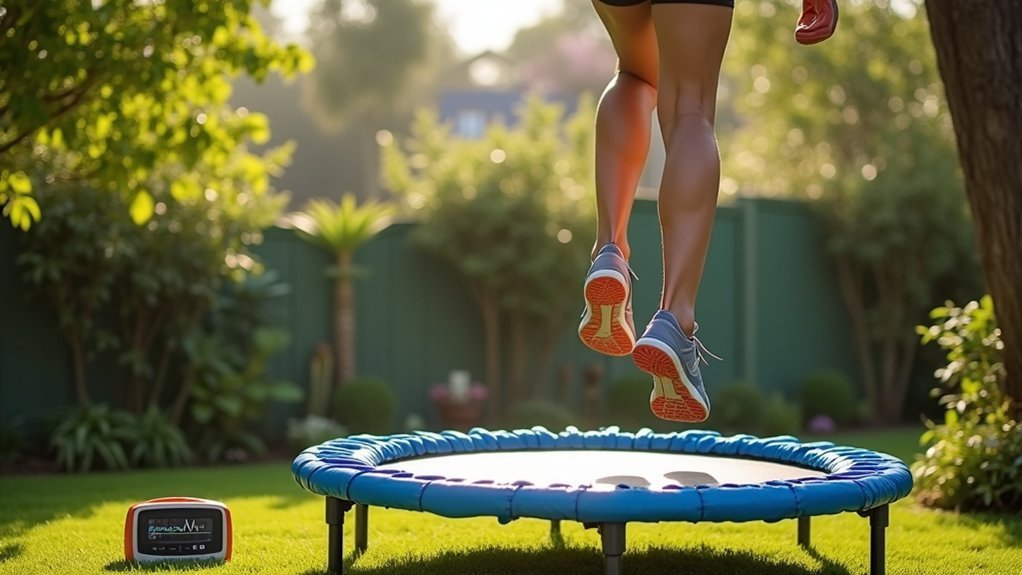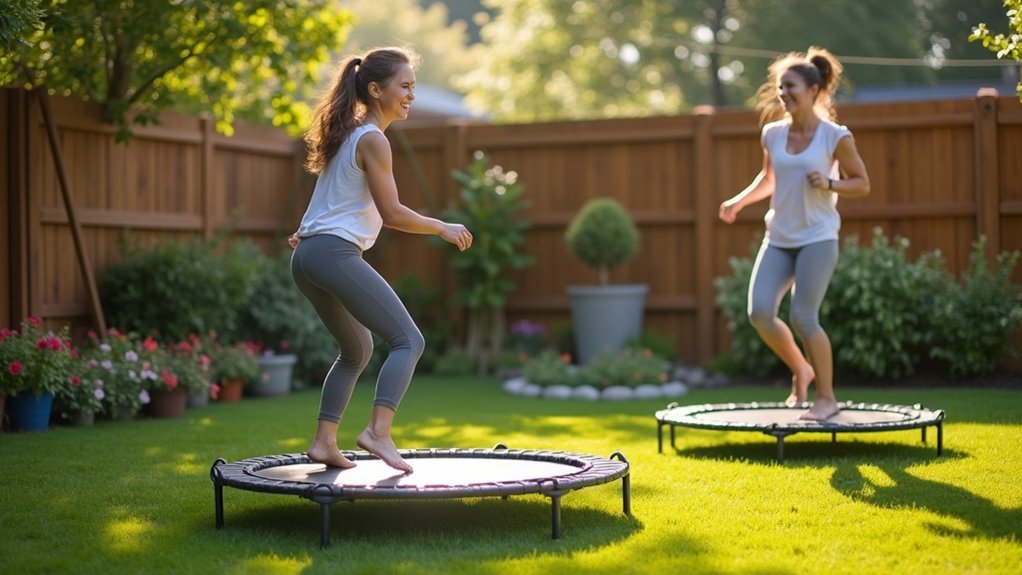To minimize neighbor disturbances during mini trampoline workouts, focus on gentle bounces with bent knees, and use noise-dampening materials like rubber mats under the trampoline legs. Choose bungee cord models over spring types, perform low-impact moves like toe taps and controlled step patterns, and schedule sessions between 8 AM and 8 PM. Adding foam pipe insulation around the frame and positioning your trampoline on carpet further reduces noise. Our detailed techniques below will transform your rebounding into a neighbor-friendly fitness routine.
The Science of Sound-Dampening Rebounding Techniques

While mini trampolines offer exceptional cardiovascular benefits, their bouncing action can create unwanted noise that disturbs neighbors or family members. You can greatly reduce noise by adopting proper biomechanics during your workout.
Focus on controlled, smooth bounces with gradual landings rather than explosive jumps. Strategically positioning your trampoline over strong support points in your floor structure can significantly minimize vibration transfer. Keep your feet close to the mat to increase energy absorption through the trampoline material instead of creating sharp impacts. Moderate your bounce height to prevent hard landings that transmit vibrations through floors.
Emphasize knee and ankle flexion during each bounce—this natural shock absorption decreases both noise and joint strain. By distributing your weight evenly across the trampoline surface, you’ll prevent localized stress points that create noise peaks and extend the life of your equipment.
Low-Impact Gentle Bounce Sequences for Shared Buildings
Living in a shared building shouldn’t mean giving up your rebounding workout routine. Focus on basic bounce sequences with feet shoulder-width apart, slightly bent knees, and engaged core to minimize noise transmission.
Instead of vigorous jumps, try rocking side to side while maintaining foot contact with the surface. San Fran Fitness offers various low impact exercises designed specifically for noise-sensitive environments. Forward toe taps and gentle heel touches create effective movement without disruptive sounds.
For variety, incorporate controlled step and tap patterns with constant light contact on the trampoline mat. The “Bounce Down” technique keeps your feet on the trampoline while you push your heels down in a squat-like position.
Slow surf twists and scissor movements performed deliberately reduce vibrations. Remember to maintain soft knees throughout your workout to absorb shock and dampen noise that might disturb neighbors.
Morning Mini Trampoline Routines That Won’t Wake the Neighbors

Working out on your mini trampoline in the morning doesn’t have to disturb your neighbors if you master the gentle bounce technique that emphasizes downward pressure rather than height.
You’ll benefit from soundproofing your setup with bungee-cord models placed on cushioned surfaces, and using rubber stabilizers to prevent floor vibrations.
For an effective yet quiet session, try low-impact cardio options like controlled scissors movements and small knee lifts that keep your feet in near-constant contact with the mat. As demonstrated in Lindsey Bushman’s workout, maintaining a slight knee bend throughout your routine helps absorb shock and reduce noise while still providing an effective workout.
Gentle Bounce Technique
Master the art of silent rebounding with the gentle bounce technique—perfect for those early morning workouts when noise is a concern. Focus on pressing down into the trampoline rather than launching upward, which greatly reduces impact noise.
Keep your core engaged and maintain a stable posture with relaxed shoulders and aligned spine. This control prevents unnecessary movement and noise. When landing, use soft foot placement—think of gently touching down rather than stomping. Press down through your heels for stability while keeping your movements measured and controlled.
Your breathing matters too. A relaxed, steady breath helps maintain control over your movements, further minimizing disruptive sounds.
Stay centered on the trampoline and use controlled, deliberate motions rather than wild bounces. This technique not only keeps noise levels down but also provides the same lymphatic and cardiovascular benefits as higher bounces.
Soundproofing Your Setup
While enjoying your mini trampoline’s health benefits, you’ll want to guarantee your morning workouts don’t turn neighbors into enemies. Strategic soundproofing begins with proper cushioning—place foam interlocking mats directly under trampoline legs to absorb vibrations before they travel through floors. The Ness trampoline offers arched legs that significantly enhance stability and reduce unwanted vibrations during your workout.
Position your trampoline away from shared walls in carpeted areas or lower floors to minimize impact transmission. For ideal noise reduction, consider:
| Surface Solution | Noise Reduction Benefit |
|---|---|
| Rubber mats | Prevents slipping and vibration transfer |
| Foam padding | Absorbs impact at contact points |
| Carpet placement | Dampens overall bounce sound |
| Cork underlayment | Blocks structural sound transmission |
Choose cord suspension trampolines over spring models to eliminate mechanical creaking, and wear wireless headphones instead of playing music through speakers. Consistent communication with neighbors about your workout schedule builds goodwill.
Low-Impact Cardio Options
If you’ve mastered the art of soundproofing your mini trampoline, you’ll still need the right workout techniques to maintain neighborly peace.
The key is focusing on low-impact movements that minimize noise while maximizing fitness benefits.
- Basic bounce and heel taps – Stand with feet shoulder-width apart, knees slightly bent, and bounce by pressing your heels down rather than jumping up. Add gentle heel taps to engage different muscles without creating disturbance.
- Smooth shifts – Move gradually between exercises like scissors and surf twists, keeping your core engaged and movements controlled to reduce impact noise. The Bounce Down Exercise establishes a solid foundation while activating core muscles and reducing noise through controlled movement.
- Morning timing strategy – Schedule workouts earlier when neighbors are likely awake, and combine cardio intervals with strength training to create an effective yet quiet routine.
Equipment Modifications to Minimize Noise Transfer

Strategic placement of your mini trampoline on thick rubber flooring or foam pads can greatly reduce noise transfer to neighbors below or next door.
You’ll want to apply silicone lubricant to any squeaky springs or joints, replacing old springs with newer, quieter models if necessary. Regular application of WD-40 Specialist Silicone can significantly minimize the friction that causes disruptive squeaking during your workout.
Consider wrapping your trampoline’s metal frame with foam pipe insulation or investing in a spring-free rebounder designed specifically for noise reduction in apartment settings.
Strategic Placement Matters
Properly positioning your mini trampoline can dramatically reduce noise transfer to neighbors and family members in your home.
Consider the surface beneath your equipment as your first line of defense against unwanted noise.
- Choose soft surfaces – Place your trampoline on carpeted areas rather than hard wood or tile floors to naturally absorb impact sounds and vibrations.
- Use strategic buffers – Position thick foam or rubber mats underneath the trampoline legs to dampen vibrations before they travel through floor joists.
- Mind your location – Keep your trampoline away from shared walls, corners, and mechanical elements like heating ducts that can amplify and conduct noise to other areas of your building.
Regular application of food-grade quality grease on the metal components of your mini trampoline will significantly reduce squeaking noises during your workout sessions.
Sound-Absorbing Accessories
Outfitting your mini trampoline with the right sound-absorbing accessories can transform a thunderous workout into a nearly silent bounce session.
Start by installing rubber or silicone leg caps to prevent metal-to-floor contact, greatly reducing structural noise transfer. These simple additions protect both your floors and your neighbors’ peace of mind.
Consider upgrading to springs with sound-damping covers or silicone coatings that eliminate that telltale metallic “ping” during workouts. Placing your trampoline on specialized rubber mats will substantially absorb shock, impact, and vibrations that might disturb those living below you.
Adding cushioned handlebar grips not only improves your comfort but also reduces vibrations traveling through the frame.
For maximum noise reduction, combine these modifications with proper maintenance.
Replace worn rubber components promptly, as deteriorated parts increase noise.
These targeted equipment upgrades work together with sound-absorbing mats to create a considerate workout environment.
Mindful Rebounding: Quiet Cardio Workout Patterns
When you need to keep noise to a minimum but still want an effective workout, mindful rebounding offers the perfect solution. By focusing on controlled movements and proper technique, you’ll reduce impact noise while maintaining cardio benefits.
Synchronize your breathing with each bounce—inhale as you rise, exhale as you land softly with bent knees. Keep your core engaged and shoulders relaxed to absorb shock and prevent jarring impacts that create noise. Moving to the edges of the rebounder can improve your balance while keeping movements quieter for neighbors below or beside you.
- Use “bounce down” movements where you press into the mat gradually rather than stomping.
- Incorporate gentle exercises like step-touches, seated bounces, and slow arm raises.
- Maintain a steady rhythm with “high bounces” (lighter, less impactful movements) interspersed throughout your routine.
Apartment-Friendly HIIT Variations Without the Thump
Living in an apartment doesn’t mean sacrificing high-intensity interval training on your mini trampoline. You can enjoy effective HIIT workouts without disturbing your neighbors.
Try “Short Interval Workouts” with low-impact shifts between exercises. Incorporate “Modified Jumping Jacks” by reducing landing intensity and “Silent Marching” with bent knees to minimize noise.
For targeting your core, “Quiet Twists” provide an excellent workout without the thump. Schedule your sessions during reasonable hours and place sound-dampening mats beneath your trampoline for additional noise reduction.
Focus on “Controlled Movement” with smooth shifts between exercises, and maintain “Steady State Cardio” with consistent, gentle bouncing.
Always keep your core engaged to stabilize movements and prevent uncontrolled bounces. Mini trampolines are actually easy on joints while providing excellent cardiorespiratory benefits, making them perfect for apartment dwellers with traditional cardio limitations. With these techniques, you’ll get an effective workout while being a considerate neighbor.
Nighttime Noise-Conscious Mini Trampoline Sessions
As darkness falls, enjoying your mini trampoline workouts requires special consideration for neighbors trying to sleep. Choose a trampoline with bungee cord suspension instead of metal springs to eliminate squeaking sounds.
Position your equipment on carpeted areas away from shared walls, and consider adding rubber isolation pads to minimize vibration transfer. Instructors recommend using low-impact rebounding workouts that maintain the fitness benefits while reducing noise transmission to neighboring units.
Strategic placement is key—carpet flooring and rubber isolation pads create a neighbor-friendly bounce zone away from shared walls.
For quiet nighttime bouncing:
- Focus on gentle movements like slow-paced jogging, controlled marches, or balance exercises that keep your feet in contact with the mat.
- Implement soft landings by bending your knees deeply and avoiding high jumps or lateral movements that create frame vibrations.
- Use accessories like handlebars to maintain stability and reduce erratic bouncing, or incorporate yoga-inspired stretches that utilize the trampoline’s surface without aggressive impacts.
Strategic Timing and Placement for Peaceful Coexistence
Successful mini trampoline workouts in shared living spaces depend heavily on strategic timing and thoughtful placement.
Schedule your bouncing sessions between 8 AM and 8 PM, with mid-morning or afternoon being ideal to respect neighbors’ quiet hours. Consistency in your workout timing helps neighbors anticipate noise periods.
Position your rebounder on carpeted areas or thick exercise mats to absorb impact. Choose rooms with enclosed walls that don’t share boundaries with neighbors’ living spaces.
Add rubber feet or silicone pads under your trampoline to minimize vibrations transferring through floors. Selecting bungee cord models over spring-based trampolines will significantly reduce noise during workouts, as these options are generally quieter during use.
Select bungee cord models over spring-based trampolines for quieter operation. Maintain distance from windows and balconies to prevent sound from traveling outdoors.
When possible, schedule workouts during weekday hours when most neighbors are typically away.
Balance-Focused Rebounding That Stays Whisper-Quiet
Balance-focused rebounding offers a uniquely effective workout that can remain virtually silent with the right techniques. By emphasizing controlled movements instead of high jumps, you’ll maintain stability while minimizing noise. Keep your feet close to the mat, focusing on the downward “stamp” rather than lifting off completely.
- Perform gentle side-to-side hip movements with a tense core to engage balance muscles without creating impact noise.
- Incorporate mindful breathing patterns (4-second box breathing) with slow bouncing to maintain control and reduce exertion sounds.
- Use small, angular foot placements like controlled scissor movements to enhance coordination quietly.
These techniques not only keep your workout neighbor-friendly but also intensify your balance training by forcing more controlled, deliberate movements that activate stabilizer muscles effectively. Remember to always focus on soft landings with slightly bent knees to significantly reduce impact noise while protecting your joints.
Frequently Asked Questions
How Long Should I Rebound to Get Cardiovascular Benefits?
You’ll gain cardiovascular benefits with 10-15 minutes of rebounding if you’re a beginner. As you advance, aim for 20-30 minutes per session, 3-4 times weekly, incorporating intervals for maximum heart health benefits.
Can Mini Trampolines Damage Hardwood Floors?
Yes, mini trampolines can damage hardwood floors. Without proper protection, their metal legs can scratch, gouge, or dent your floors. You’ll need rubber mats underneath and intact leg caps to prevent damage.
Are Quiet Trampolines Still Effective for Weight Loss?
Yes, quiet trampolines are equally effective for weight loss. You’ll still burn 200-600 calories per hour depending on your intensity. The bungee cord design that makes them quieter doesn’t compromise their weight loss benefits.
How Often Should I Replace My Mini Trampoline?
You should replace your mini trampoline every 3-8 years, but inspect components regularly. Replace elastic cords every 2 years, mats at first sign of damage, and tighten parts monthly to extend its lifespan considerably.
Can Seniors Safely Use Mini Trampolines for Low-Impact Exercise?
Yes, you can safely use mini trampolines as a senior for excellent low-impact exercise. Start with gentle bounces, use handrails if needed, and always check with your doctor first regarding your specific health conditions.
In Summary
You’ll find rebounding doesn’t have to ruffle neighborhood feathers. With sound-dampening mats, gentler bouncing techniques, and strategic timing, you’re well-equipped to enjoy all the benefits without the noise complaints. Remember, it’s the mindful approach that makes the difference—lower bounces, proper equipment placement, and considerate workout scheduling. Your fitness journey and neighborly relations can both thrive when you embrace these quiet rebounding strategies.





Leave a Reply